Faculty Performance Series to Feature Work Composed by HBMS Faculty Member Derek Cooper on 10-28
- Details
- Written by Joanne Wallenstein
- Hits: 1151
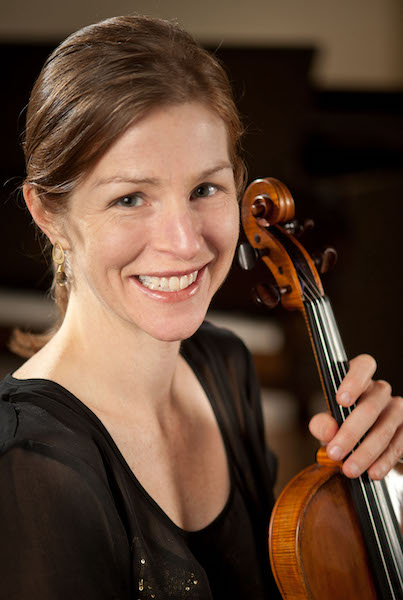 April JohnsonThe 2022-2023 HB Artist Faculty Performance Series continues Friday, October 28, 2022, at 7:30 pm with a performance of faculty member Derek Cooper's composition Survivor: 4 Autobiographical Pieces for Countertenor and Piano as well as works by J.S. Bach, Clara Schumann and Eric Ewazen performed by faculty members April Johnson, violin; Peter Seidenberg, cello; and pianists Dominic Meiman, Delana Thomsen and Tomoko Uchino.
April JohnsonThe 2022-2023 HB Artist Faculty Performance Series continues Friday, October 28, 2022, at 7:30 pm with a performance of faculty member Derek Cooper's composition Survivor: 4 Autobiographical Pieces for Countertenor and Piano as well as works by J.S. Bach, Clara Schumann and Eric Ewazen performed by faculty members April Johnson, violin; Peter Seidenberg, cello; and pianists Dominic Meiman, Delana Thomsen and Tomoko Uchino.
Joining the faculty are guest artists countertenor Robert Francis Orbach, pianist Lauren Ninoshvili and Darlene Kaukoranta, horn. The concert will be held in the School’s Joan Behrens Bergman Auditorium, 25 School Lane, Scarsdale, New York. Program and performers subject to change.
Admission
Admission to the concert is $20 general admission and is free of charge to HBMS students. Tickets may be purchased in advance via Eventbrite, the School’s website (www.hbms.org), by calling 914-723-1169, or e-mailing hb@hbms.org.
For Additional Information call 914-723-1169, email hb@hbms.org, or visit www.hbms.org.
About the HB Artist Faculty Concert Series
Hoff-Barthelson faculty comprises some of the nation’s most distinguished performers and educators. Many hold chairs in prominent New York orchestras, are members of world-class chamber ensembles, perform in major Broadway productions, and are in international demand as solo artists. Others teach at leading conservatories including The Juilliard School, Manhattan School of Music, and Mannes College of Music. Held in Scarsdale, these concerts guarantee riveting music making of the highest caliber, in an intimate setting, at prices far below those in New York’s major concert halls.
Additional concerts in the series will be held November 18, 2022, and February 10, March 3, and April 14, 2023.
About the Faculty Artists
Derek Cooper’s music has been performed worldwide by groups including Contemporaneous, Sonic Apricity, the Indiana University of Pennsylvania Wind Ensemble, Jenny Lin, Yarn/Wire, Ekmeles, the Iridium Saxophone Quartet, and Blueshift Ensemble. His piece, Kill James, was awarded the New York Composers Circle’s 2019 award at the John Eaton Memorial Composition Competition. 2020 gave way to virtual performances and Derek’s Miniatures Project, Vol. 1: Puzzles. The project has been hailed as being a unique and skillful way to redefine composition during the pandemic. The project has garnered attention from around the world.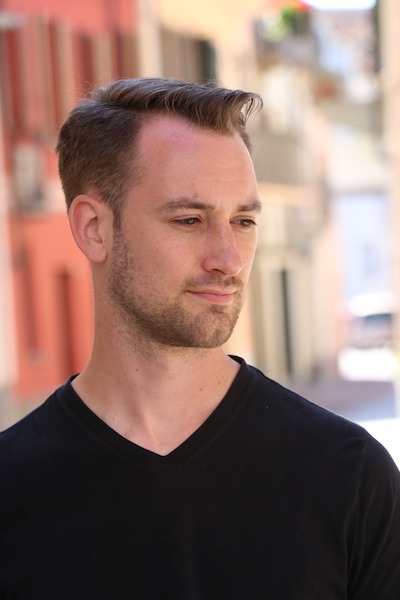 Derek Cooper
Derek Cooper
Violinist April Johnson has performed throughout the U.S. as soloist, chamber musician and orchestral freelancer. She has appeared as concertmaster with the Jupiter Symphony and the Galatea Ensemble, the Queens Oratorio Society and the Canton Symphony of Canton, Ohio. She has also performed with the Norwalk Symphony as assistant concertmaster, and the New York Chamber Soloists, the Ridgefield, Bridgeport, New Haven, Fairfield, Harrisburg Symphony Orchestras, and the Pennsylvania Philharmonia. With her husband, cellist Peter Seidenberg and pianist Kate Boyd, she is a member of The Oracle Trio. She has recorded with Lyrichord, Dorian and Newport Classics labels.
In addition to his teaching, Dominic Meiman has worked as a pianist/conductor on several Columbia Artists Management national tours. For several years, he was the principal pianist for the Light Opera of Manhattan, performing most of the Gilbert and Sullivan canon. Mr. Meiman is the composer of the children’s opera, Jack and the Beanstalk and is the arranger and co-librettist/lyricist of The Ring of the Fettuccines, an introduction to opera for children. He also orchestrated the show The Night They Invented Champagne, Operettas and the Musicals They Influenced.
Peter Seidenberg has performed in major halls throughout the U.S., Europe, and Asia. He made his solo debut with the Chicago Symphony, and has since appeared as soloist with many orchestras, including the Century Orchestra of Osaka, Japan, the New American Chamber Orchestra, the De Paul Chamber Orchestra, New York Chamber Soloists, and the Eastman Rochester Philharmonic. He was founding member of the critically acclaimed Elements Quartet which created groundbreaking commissioning projects involving over 30 composers. He has collaborated with members of the Cleveland, Tokyo, Juilliard, and Emerson Quartets, and has participated in the Marlboro, Aspen, Caramoor, Casals, and Norfolk Festivals.
Delana Thomsen is a highly accomplished solo and collaborative pianist who has given recitals throughout Europe and the US, as well as Master Classes in Iceland, Bulgaria, and Italy. She has appeared at numerous venues including Carnegie Weill Recital Hall and been affiliated with InterHarmony International Music Festival; Aspen Music Festival; Juilliard; Mannes College of Music and she performs regularly with the Thomsen-Belli piano duo and SAGA ensemble. Ms. Thomsen was invited to perform with violinist Gudny Gudmundsdottir for Mozartmarathon Tónleiker in Reykjavik, Iceland in 2018 with an acclaimed all Mozart program.
Tomoko Uchino has performed in recitals and concerts throughout the United States, Europe, and Asia. As a soloist, she has been a top prize winner in such competitions as the Ettlingen International Piano Competition for Young Pianists in Germany and the Takahiro Sonoda Piano Award International Competition in Japan. She has also appeared in recitals, collaborating with numerous instrumentalists and vocalists in such concert halls as Alice Tully Hall at Lincoln Center, Carnegie Weill Hall, Herbst Theater in San Francisco and Hamarikyu Hall in Tokyo, Japan.
For complete faculty artist biographies click here.
Your Right to Choose Is Sacred
- Details
- Written by Canto Amanda Kleinman
- Hits: 1792
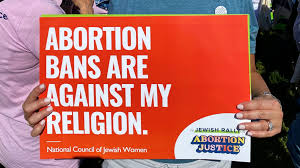 (This Kol Nidre sermon was delivered by Cantor Amanda Kleinman at Westchester Reform Temple)
(This Kol Nidre sermon was delivered by Cantor Amanda Kleinman at Westchester Reform Temple)
I’d like to begin my sermon tonight by giving a plug to someone else’s sermon. Last spring, Emily Levine, a member of our tenth grade Confirmation class, delivered an eloquent and insightful D’var Torah advocating for reproductive rights from a Jewish perspective. Emily began by saying, “I’m going to be completely honest. When I realized during Confirmation that I wanted to talk about abortion at temple, I wasn’t sure how the clergy was going to respond. I had a whole speech planned in case they told me it was ‘too controversial.’”
As a woman, as a mother, and as a Jew, it was painful for me to hear a young person question whether temple was the appropriate place to stand up for women’s rights. Painful, but not surprising. In fact, every year when I teach this topic in Confirmation, I begin by asking what students think the Jewish tradition has to say about abortion. Without fail, they assume that Judaism prohibits it. The reason I ask the question in the first place is because, for most of my life, I assumed that the protests I saw when I drove past Planned Parenthood, you know the ones - religious leaders speaking passionately into megaphones flanked by signs quoting Biblical verses - represented the viewpoint of all religious traditions, including my own. It wasn’t until I was studying to be a cantor that I learned that Judaism actually affirms a woman’s right to choose.
The idea that our Jewish tradition would sanctify our ability to make our own choices can feel surprising, if not unsettling. Religion is supposed to make our choices for us, right? Religion is supposed to offer us moral clarity. As the product of an Orthodox Jewish day school, and having been raised, at least in part, in an Orthodox community, I understand firsthand the feeling that religion is supposed to offer us firm answers, certainty, and direction.
Baptist minister Katey Zeh, who also serves as the CEO of the Religious Coalition for Reproductive Choice, questions this tendency to look to religion for absolutes. She reflects: “I grew up in a . . . conservative, white, Evangelical church, so I am very familiar with a theological framework that is cut and dry, that things are this or they’re not, that God is this or God isn’t. There is a certain comfort that if I simply follow these rules, then my life will be wonderful. I subscribed to that for a long time until I had experiences that required me to do a lot of soul searching around what it means to be a faithful person with a theological framework that allows for nuance and complexity.”
In fact, Judaism is all about nuance and complexity. The Jewish tradition has never been one of absolutes. Look at the Talmud, the seventh century rabbinic text that became the foundational building block of Jewish law. The Talmud preserves thousands of pages of rabbinic arguments and counter-arguments across centuries. When the rabbis do not reach consensus, the Talmud’s redactors conclude the argument simply with the word “Teiku,” or “Let it stand” as an unresolved issue. In one particularly powerful example, after three years of especially rancorous debate between the house of Hillel and the house of Shammai, a heavenly voice descends to announce, “Eilu v’eilu divrei Elohim chaim heim,” Both viewpoints are words of the living God.
Our Reform movement goes even a step beyond valuing debate and discussion; we uphold the value of individual autonomy and sanctify it as a moral obligation. In 1937, our Reform rabbis declared, “As a child of God, man is endowed with moral freedom.” Forty years later, they affirmed, “Reform Jews are called upon to . . . to exercise their individual autonomy, choosing and creating on the basis of commitment and knowledge.” In other words, for us as Reform Jews, autonomy is not only a privilege, or even a right; it takes on the status of mitzvah, of sacred responsibility.
If only our current Supreme Court agreed. Thirty years ago, in Casey v. Planned Parenthood, the Supreme Court made the bold statement that “At the heart of liberty is the right to define one’s own concept of existence, of meaning, of the universe, and of the mystery of human life.” A woman’s ability to make “intimate and personal choices” was regarded as “central to personal dignity and autonomy.” This summer’s Dobbs decision, however, rolled back the clock on women’s autonomy almost fifty years, to a time when a woman couldn’t get a credit card without her husband’s signature on the application, and when some states still systematically excluded women from juries. The justices wrote in the Dobbs decision, “These attempts to justify abortion through appeals to a broader right to autonomy and to define one’s ‘concept of existence’ prove too much. Those criteria, at a high level of generality, (and they actually wrote this) could license fundamental rights to illicit drug use, prostitution, and the like. None of these rights has any claim to being deeply rooted in history.”
I beg to differ. My history has always upheld the sanctity of life AND given priority to the life and well-being of the mother. Over a thousand years ago, the Talmud taught: “The fetus is the thigh of the mother,” and elsewhere, “The fetus is her body,” making clear that, in Judaism, the health and wellbeing of the pregnant woman takes precedence over that of the fetus. When the mother’s life is threatened, Judaism actually requires termination of the pregnancy. Even when the physical health of the mother is not at stake, our tradition gives us space to consider each pregnant woman’s unique circumstances, in many cases permitting abortion when the primary concern is a woman’s emotional well-being. And I’m not talking only about our liberal Reform tradition; in fact, these texts and interpretations come straight out of Orthodox Jewish practice.
It is, nevertheless, important to note that our traditional texts were written by men. Halakha, the traditional Jewish legal system, leaves something to be desired when it comes to women’s autonomy, generally giving the authority to sanction an abortion to a male rabbi. My colleague, Rabbi Hannah Goldstein, who delivered a beautiful sermon on this topic over Rosh Hashanah, calls it “fighting patriarchy with patriarchy.” Yet, I am proud to be part of a religious tradition that gives real consideration to women’s needs, and I am especially proud to be part of a Reform movement that sanctifies “the legal right of a woman to act in accordance with the moral and religious dictates of her conscience.” In Reform Judaism, the final authority about how we live our Jewish values does not reside with the cantor or the rabbi, or some other governing body or institution. It resides within each of us.
As I prepared this sermon, I had the opportunity to speak with a number of you, our congregants, who are affected by this threat to reproductive choice. I was so grateful for your candor. I spoke with Lisa Eisenstein who, as a young person, was so aghast to learn that women could be denied access to basic health care, that she became a champion of reproductive freedom and served for many years on the board of Planned Parenthood, only to see much of what she worked so hard to protect erased. I spoke with Dr. Susan Klugman, a national leader in the field of reproductive genetics, who told me that her colleagues in other states are reluctant to share reproductive options with their patients for fear of going to jail. A few of you told me stories of your own abortions, each of you grateful for the choice that was available to you, and also horrified that, for many, that same choice is unavailable today.
At a time in my life when I needed to consider my reproductive choices, I consulted my then doctor who came from a devout Catholic background. Years earlier, we had bonded over being people of faith; delighted when I shared that I was a cantor, she told me that her own mother had once been a nun, and that she thought we had a lot in common. When I asked her my questions, I sensed her inner struggle. If we were both people of faith, how could my values be so different from hers? At my next visit, she surprised me when she said that she intended to support me, regardless of my choice. While I cannot know exactly what she was thinking, I like to imagine that she decided to trust me to make a decision guided by my own values, a decision that would be between me and my God. It was a tremendously powerful moment of personal validation, not only of being entrusted with my own choices, but of being supported through those choices, even when the person offering the support might disagree with my decision.
As we stand on the precipice of a new year, the first in a long while that doesn’t guarantee a woman’s right to choose here in America, let us turn to the words of the prayer for which this evening’s service is named, Kol Nidre. The Kol Nidre prayer reads: “All vows - resolves and commitments, vows of abstinence and terms of obligation, sworn promises and oaths of dedication - that we take upon ourselves from this Day of Atonement until next Day of Atonement, let all of them be discarded and forgiven, abolished and undone; they are not valid and they are not binding.”
A little-known fact: the rabbis tried to get rid of the Kol Nidre prayer for literally thousands of years, fearing that a statement nullifying future vows plays into stereotypes that Jews can’t be counted on to fulfill their promises. Rabbi David Stern, son of WRT’s beloved Rabbi Jack Stern, of blessed memory, and who, by the way, gave me my own entry point into Reform Judaism as my family’s rabbi in Dallas, offers another interpretation. He writes, “Kol Nidre grants us the gift of sacred uncertainty, the chance to begin this new year with a sense of what we do not know, rather than a narrow certainty about what we do.” In other words, the authors of the prayer recognized that our tradition cannot provide us with all the answers; instead, Kol Nidre empowers us to make the best choices we can, and the comfort of knowing that God will forgive us if we transgress. This Yom Kippur, let us pray for the confidence to make our own choices, and for the humility to support the choices of others.
And so, to you, Emily, I say thank you. I am so glad you were brave enough to ask the “controversial” question. Why make assumptions when we can just ask? Temple is exactly the place to grapple with difficult questions, so that you can come away with your own understanding, rooted in our community’s shared values. Clearly, we haven’t yet shouted it from the rooftops, so I’ll shout it from this bima on the holiest day of the year: your religious tradition, your temple, and your clergy consider your right to choose to be sacred.
Scarsdale-Related Photos and Documents Sought for Scanning Event
- Details
- Written by Joanne Wallenstein
- Hits: 843
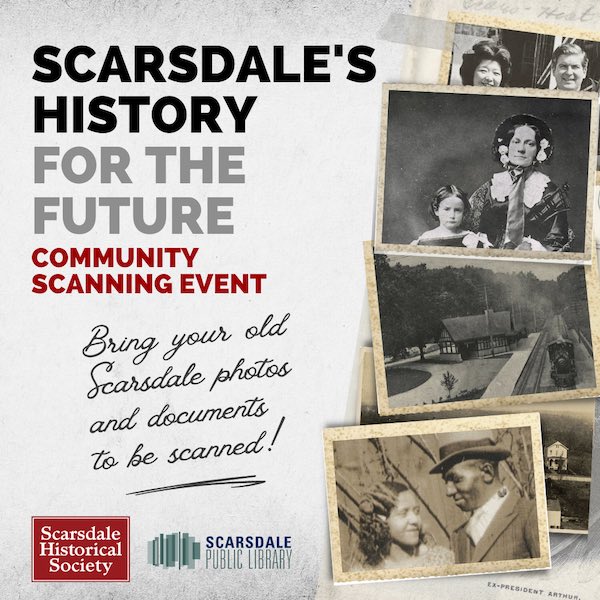 Scarsdale Historical Society to Preserve Memories for Archives
Scarsdale Historical Society to Preserve Memories for Archives
The Scarsdale Historical Society is pleased to announce “Scarsdale’s History for the Future,” an upcoming community scanning event on Saturday, October 1st from 1:00-3:00 PM at the Scarsdale Public Library. The community is asked to bring in their Scarsdale-related historic photos and documents that can be digitized, at no charge, and any media will become part of the Village’s archives.
The project is part of the Scarsdale Historical Society’s mission to preserve and share Scarsdale’s unique and continuing history. The organization is seeking old photographs, fliers, diaries or documents – anything that tells the story of Scarsdale and its residents. Paper documents and photographs no larger than 11 inches by 17 inches may be digitized during the scanning event. If items brought cannot be scanned at that time for any reason, other arrangements can be made.
During the scanning event, visitors will also enjoy a small exhibition featuring items from Scarsdale’s history, and also a selection of rare artifacts that have national importance. The Scarsdale Public Library will be showing a book of town minutes starting in the 18th century; Scarsdale High School yearbooks from the 1930s; and maps of the village from the 19th and early 20th centuries.
Seth Kaller, a leading American history dealer and collection-builder and a Scarsdale Historical Society trustee, will display valuable original documents and artifacts, including: the only copy in private hands of New York’s first printing of the Declaration of Independence (July 11, 1776; not Scarsdale, but close – the state’s assembly met in White Plains to vote in favor of independence, and the document was printed in New York City near Wall Street); one of Alexander Hamilton’s most revealing love letters to Eliza, written from Dobbs Ferry in 1780; Jesse Owens Congressional Gold medal; Ruth Bader Ginsburg’s law books; and a NY Votes for Women suffrage broadside.
“We encourage everyone to dust off Scarsdale-related photos and documents from their attics and basements so they can be properly preserved and enjoyed for years to come,” stated Randy Guggenheimer, President of the Scarsdale Historical Society. “We are grateful to the staff at the Scarsdale Public Library for making this effort possible.”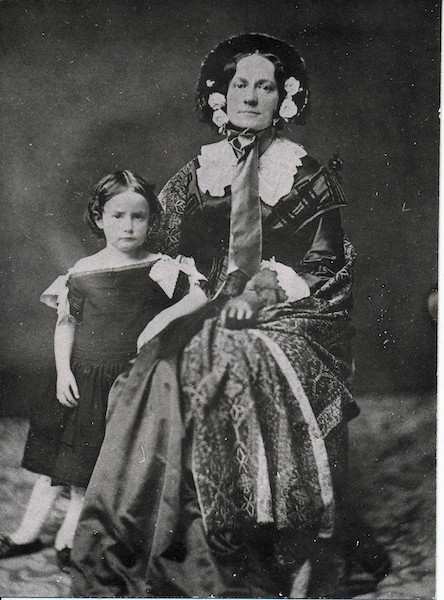 Nineteenth-century Scarsdale resident Valeria Dean Burgess with child, a photo that has been donated to the Scarsdale Public Library archives. Historic photos from all eras are welcome at the scanning event.
Nineteenth-century Scarsdale resident Valeria Dean Burgess with child, a photo that has been donated to the Scarsdale Public Library archives. Historic photos from all eras are welcome at the scanning event.
Registration for the scanning is encouraged at https://www.scarsdalelibrary.org/event/history-future. Questions can be emailed to info@scarsdalehistoricalsociety.org.
About the Scarsdale Historical Society
The Scarsdale Historical Society exists to discover, preserve, and disseminate historical information, as well as inspire others to learn about and contribute to the history of Scarsdale and the Central Mid-Westchester Region. The Scarsdale Historical Society accepts grant applications for projects that meet its mission, particularly those that will inspire others to learn about the history of Scarsdale and the surrounding communities. Learn more at www.scarsdalehistoricalsociety.org.
Historical Treasures Enter Scarsdale's Digital Archive
- Details
- Written by Joanne Wallenstein
- Hits: 1104
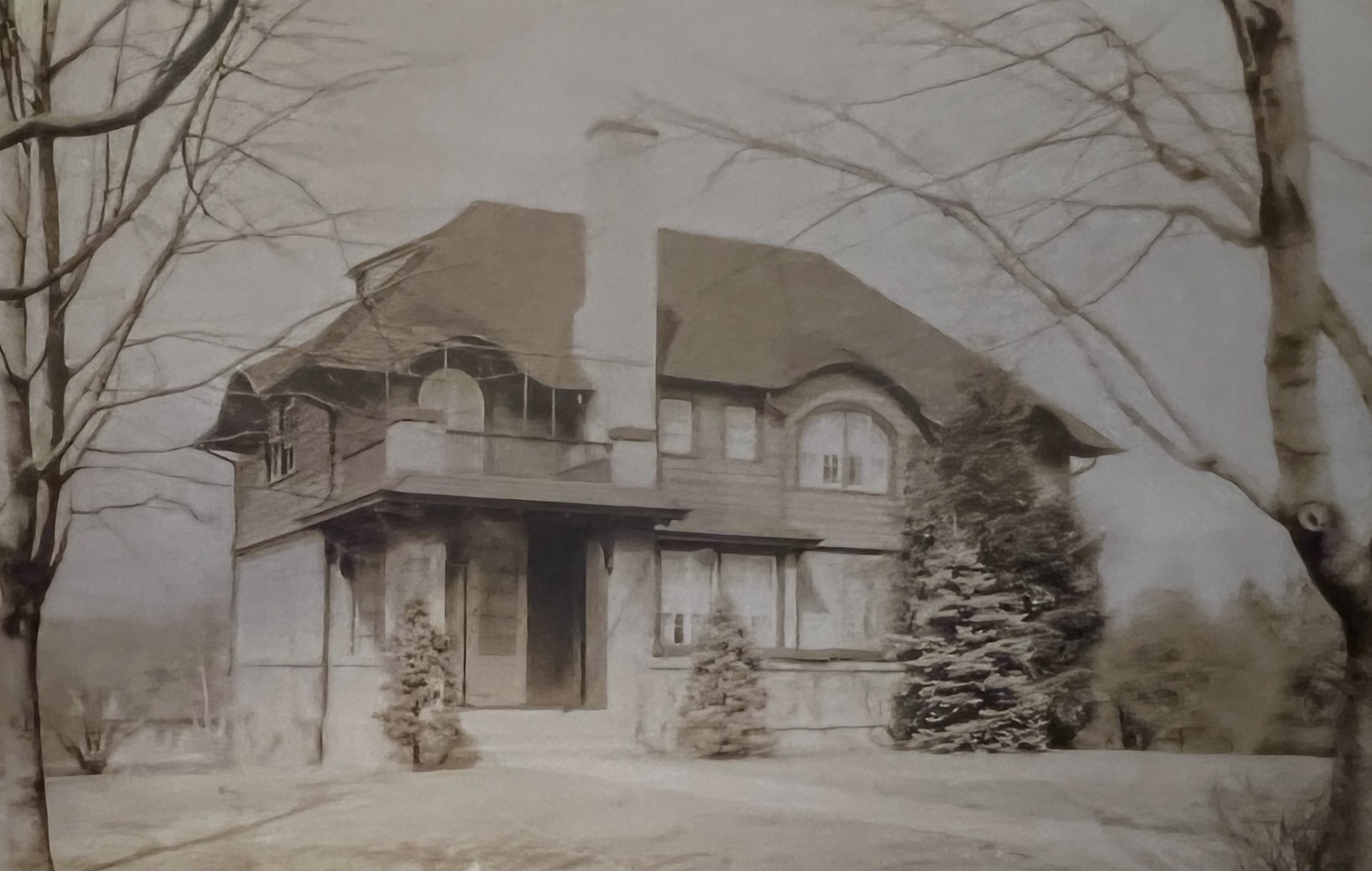 A faded postcard of my 1912 home that I inherited when we purchased our house in 1990 has been sitting on my mantle ever since. At the time, the house looked more like an Adirondack lodge than a suburban residence.
A faded postcard of my 1912 home that I inherited when we purchased our house in 1990 has been sitting on my mantle ever since. At the time, the house looked more like an Adirondack lodge than a suburban residence.
Prompted by an event sponsored by the Scarsdale Historical Society on Sunday October 2, I pulled the photo out of its frame and found a note affixed to the back from the home’s second owner. Her note provided me with the name of the original owner and it was startling to realize that in 110 year only three families have lived here.
I took my postcard to the library and found others with historical mementos, documents, maps and photos of Scarsdale which the historical society scanned for digital preservation.
Some of the trove that was scanned that day included an original 1926 brochure for an auction of 234 residential plots in Heathcote Crest owned by Michael Zeller. Just like today, the auction was to be held in a tent. The brochure promised the installation of water in every street and every lot and said, “gas and electric now available.”
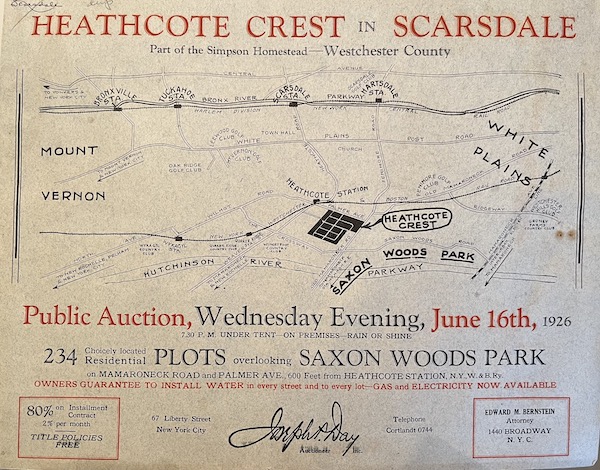 Announcement of the auction of plots in Heathcote Crest in 1926
Announcement of the auction of plots in Heathcote Crest in 1926
Also on view was this portrait of William Bailey Lang, one of the oldest of New York's iron merchants, who built Rowsley Cottage at 37 Drake Road in 1858 (now the home of the Scarsdale Women's Club). The photo is dated 1886 and was donated by the Scarsdale Women's Club. It's the first photo of Mr. Lang to become part of the Scarsdale Public Library's digital collection.
I met Diana Kiel and Les Jacobowitz, who brought in many treasures related to the Charles W. Dickel estate that was once on Post Road in Greenacres.
Christine Weston, now President of the Crane Berkeley neighborhood association brought in years of documents to scan. Among these was an invitation to a neighborhood clambake in 1973 with “coffee, tea and Sanka” served with dessert.
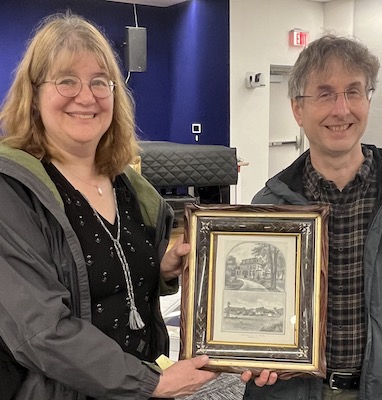 Diana Kiel and Les Jacobowitz display a photo of the Charles W. Dickel EstateFormer Scarsdale resident Seth Kaller brought an exhibit of some of the letters and documents from his collection including a letter relating to the Battle of White Plains that was fought in Scarsdale, and a copy of the Reynolds Pamphlet, which some may remember from the musical Hamilton.
Diana Kiel and Les Jacobowitz display a photo of the Charles W. Dickel EstateFormer Scarsdale resident Seth Kaller brought an exhibit of some of the letters and documents from his collection including a letter relating to the Battle of White Plains that was fought in Scarsdale, and a copy of the Reynolds Pamphlet, which some may remember from the musical Hamilton.
Leslie Chang from the Scarsdale Historical Society said, “It was very exciting to see new Scarsdale treasures coming in for digital preservation, and I was thrilled the setting was so social and collaborative. I didn’t anticipate how much lively conversation there would be with all of the attendees enjoying and discussing each other’s mementos.”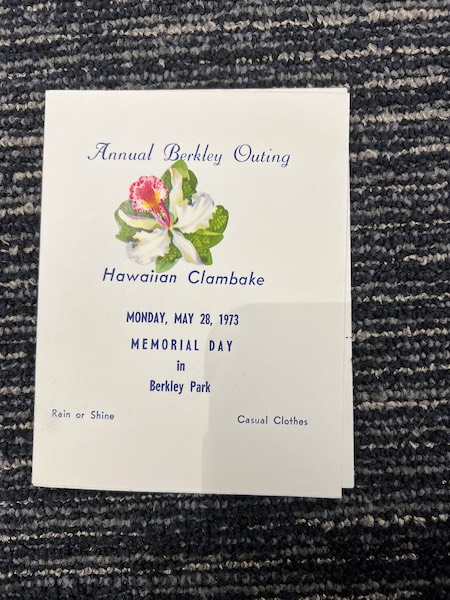
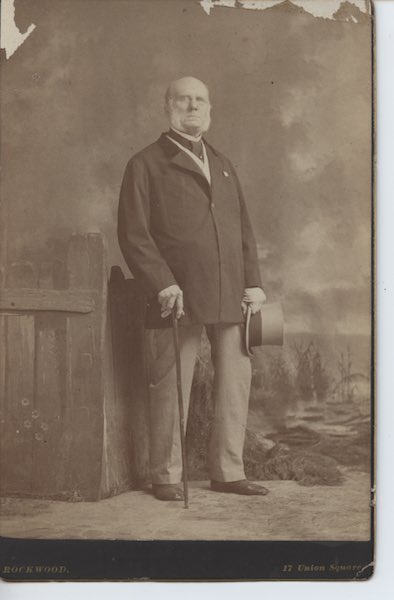 William Bailey Lang
William Bailey Lang
Scarsdale Boys Soccer Team is 7-0 and First in the State
- Details
- Written by Hadley Schwall
- Hits: 3042
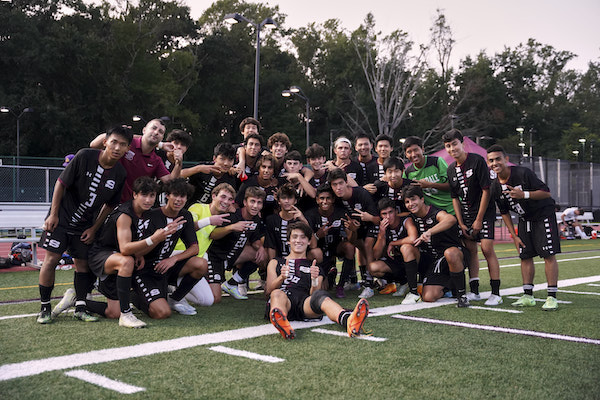 (Updated September 22) Sixth in the nation. First in the state. Scarsdale Boys Varsity Soccer has made a name for themselves with a tremendous 7-0 start to the season. Since a heavy loss to Mamaroneck in the section finals last fall, they have only grown stronger and more connected than ever.
(Updated September 22) Sixth in the nation. First in the state. Scarsdale Boys Varsity Soccer has made a name for themselves with a tremendous 7-0 start to the season. Since a heavy loss to Mamaroneck in the section finals last fall, they have only grown stronger and more connected than ever.
With only one goal conceded this season, goalie Lucas Kantor is determined to keep that statistic running. He works harmoniously with defenders Alex Duval, Matthew Choe, Zach Ruback, and David Wang. They make up this strong foundation that allows for such success offensively. On the other end of the field the team's striker, Leo Khang, uses his elite finishing abilities to fire balls into the net. Rising star, Lev Stahl, at defensive midfielder, has become a key component to the team's movement on the field and wins every aerial duel he encounters.
There would be no team without the Galeano Brothers. Captain Nico Galeano at central attacking midfielder, has shown us time and time again his playmaking skills and vision on the field. Last week he was voted Lohud Player of the Week after his overtime goal to win the game against Arlington. His younger brother, Lorenzo Galeano, does not live the name down. He displays dribbling skills, gliding by defenders, and draws fouls with ease. Their brotherly connection, that has been developing since the days of 1v1’s in their basement, is evident on the field.
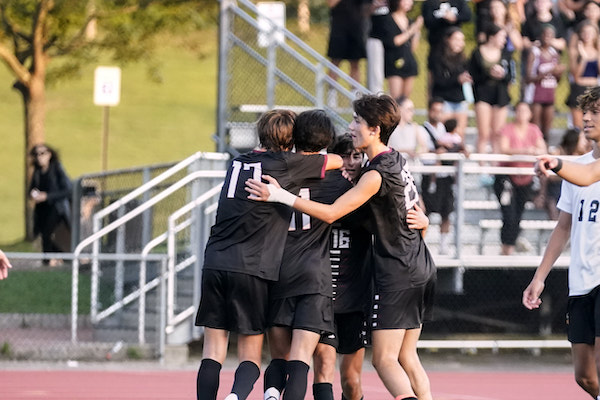
It figures that eight of the eleven starters play together on the New York Premiere Football Club, thus continuing their joint training in the offseason, furthering their innate interconnectedness. Their coach, Marcos Monteagudo, sees their potential to go far this season and knows how to get them fired up and keep their infectious momentum rolling.
Dominating the field in all of their matches thus far and defeating rival Mamaroneck last Wednesday, not only have they asserted themselves as a force to be reckoned with, but a brotherhood on and off the field.
Footnote:
On Tuesday 9/19 the team continued its winning streak, defeating Mt. Vernon 4-1 in a home game at Scarsdale.
Coming up:
Thursday away v John Jay @5
Saturday away v Harrison @6
Article by Hadley Schwall, photos by Elliott Zhang. See more here.
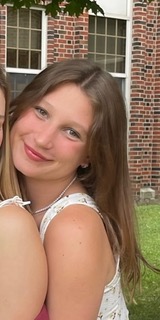 Hadley Schwall is a Scarsdale High School Senoir who loves to write both as a journalist and creatively. She also dances ballet and is an active member of the Scarsdale community.
Hadley Schwall is a Scarsdale High School Senoir who loves to write both as a journalist and creatively. She also dances ballet and is an active member of the Scarsdale community.














